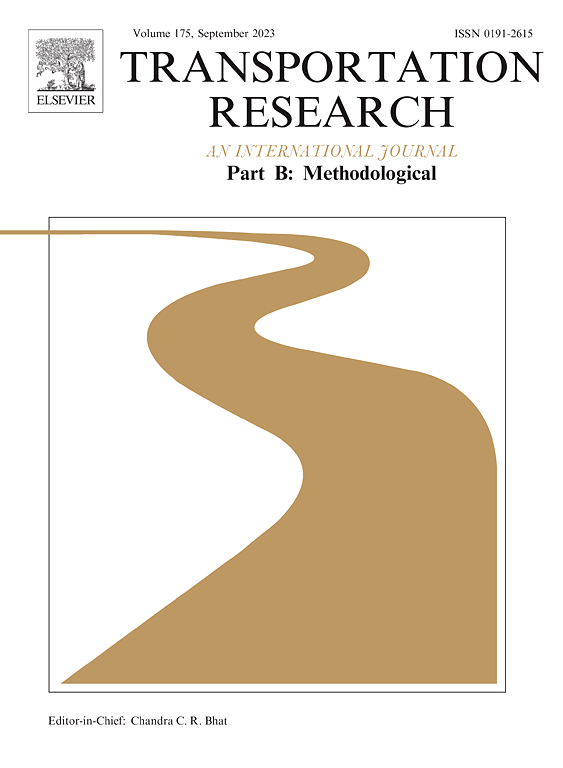Microscopic Discontinuities Disrupting Hydrodynamic and Continuum Traffic Flow Models
IF 5.8
1区 工程技术
Q1 ECONOMICS
引用次数: 0
Abstract
This paper explores short duration disturbances in the traffic stream that are large enough to impact the traffic dynamics and disrupt stationarity when establishing the fundamental diagram, FD, but small enough that they are below the resolution of conventional vehicle detector data and cannot be seen using conventional methods. This empirical research develops the Exclusionary Vehicle Aggregation method (EVA) to extract high fidelity time series data from conventional loop detectors and then extends the method to measure the standard deviation of headways in a given fixed time sample, stdevh. Using loop detector data spanning 18 years and five sites, all of the sites show that samples with low stdevh tend towards a triangular FD while samples with high stdevh tend towards a concave FD that falls inside the triangular FD. The stdevh is also shown to be strongly correlated with the duration of the longest headway within the sample. The presence of a long headway means the state is perceptively different over the sample and thus, the measurement is non-stationary. A review of the earliest FD literature by Greenshields finds strong supporting evidence for these trends. Collectively, the loop detector and historical FD results span over 75 years of empirical traffic data.
Based on the EVA analysis, this work offers the following insights: the shape of equilibrium FD appears to be triangular and that conventional detector data mask critical features needed by hydrodynamic traffic flow models, HdTFM. Because the driver behind a long headway can act independent of their leader, the long headways can correspond to unobserved boundary conditions that generate kinematic waves. If these boundaries were detected many HdTFM could accommodate them, especially multi-class models. But the stochastic nature of the long headways also challenges the predictive abilities of deterministic HdTFM. Perhaps the largest of these challenges is driver agency- the driver behind a long headway can maintain it, resulting in signals propagating downstream or they can close the gap, resulting in signals propagating upstream. Meanwhile, this work provides a test for stationary conditions to help ensure an empirical FD supports the assumptions placed upon it.
扰乱流体力学和连续交通流模型的微观不连续性
本文探讨了交通流中的短时干扰,这些干扰大到足以影响交通动态,并在建立基本图(FD)时破坏静态,但又小到低于常规车辆检测器数据的分辨率,无法用常规方法看到。这项实证研究开发了排除性车辆聚合方法(EVA),从传统环路检测器中提取高保真时间序列数据,然后将该方法扩展到测量给定固定时间样本中的车行道标准偏差 stdevh。通过使用跨越 18 年和 5 个站点的环路检测器数据,所有站点都显示出,stdevh 低的样本趋向于三角形 FD,而 stdevh 高的样本趋向于三角形 FD 内部的凹形 FD。此外,stdevh 还与样本中最长航程的持续时间密切相关。最长时间间隔的存在意味着在整个样本中状态的感知是不同的,因此测量是非平稳的。Greenshields 对最早的 FD 文献进行了回顾,发现了这些趋势的有力佐证。基于 EVA 分析,这项研究提出了以下见解:平衡 FD 的形状似乎是三角形的,传统的检测器数据掩盖了流体力学交通流模型(HdTFM)所需的关键特征。由于长车头后面的驾驶员可以独立于他们的领导者行事,因此长车头可能对应于未被观测到的边界条件,从而产生运动波。如果能检测到这些边界条件,许多 HdTFM(尤其是多类模型)就能适应它们。但是,长航向的随机性也对确定性 HdTFM 的预测能力提出了挑战。这些挑战中最大的可能是驾驶员的作用--长距离车流后方的驾驶员可以保持长距离车流,导致信号向下游传播,也可以缩小车流间隙,导致信号向上游传播。同时,这项工作提供了静态条件测试,以帮助确保经验性 FD 支持其假设。
本文章由计算机程序翻译,如有差异,请以英文原文为准。
求助全文
约1分钟内获得全文
求助全文
来源期刊
CiteScore
12.40
自引率
8.80%
发文量
143
审稿时长
14.1 weeks
期刊介绍:
Transportation Research: Part B publishes papers on all methodological aspects of the subject, particularly those that require mathematical analysis. The general theme of the journal is the development and solution of problems that are adequately motivated to deal with important aspects of the design and/or analysis of transportation systems. Areas covered include: traffic flow; design and analysis of transportation networks; control and scheduling; optimization; queuing theory; logistics; supply chains; development and application of statistical, econometric and mathematical models to address transportation problems; cost models; pricing and/or investment; traveler or shipper behavior; cost-benefit methodologies.

 求助内容:
求助内容: 应助结果提醒方式:
应助结果提醒方式:


